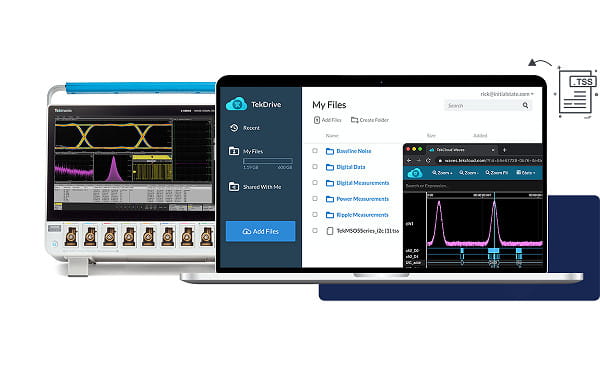Remote Oscilloscope Control Accelerates Electronic Testing

Remote control, remote analysis, and automation are simplifying and accelerating the development of electronic systems and devices. Electronics have long been heading towards remote operations, further perpetuated by the rise of remote work during the pandemic. With engineers frequently operating hazardous equipment like dynamometers, removing personnel from risk has always been a priority. Now we have the tools to work remotely while also fostering collaboration and producing products more quickly.
Remote control capabilities enable engineers to duplicate the front panel of an oscilloscope on a remote PC, whether at home or in a different country. Employees can work together without being in the same location, or even the same time zone.
Engineers can control the oscilloscope, retrieve data from it, and perform measurements and analysis all remotely using e*Scope, a built-in web server that extends a scopes UI to a PC, TekScope PC, a standalone application that replicates many of the oscilloscope capabilities, or tm_devices, Tektronix’s Python driver package.
Using a web browser for remote control
Tektronix oscilloscopes can be controlled remotely using their built-in web servers. This allows for the real-time display and user interface to run on a web browser as if the engineer was at the instrument with a mouse and keyboard. Anyone with the IP address and access to the LAN can see and control the oscilloscope. This accessibility extends to various devices, such as computers, smartphones, or tablets, and can be facilitated through different network connections, including Ethernet cables, a LAN with a network switch or router, or a VPN.
Which oscilloscopes can handle this?
Many modern oscilloscopes, such as the new Tektronix 4 Series B MSO, have a built-in web server. This remote user interface, called e*Scope, lets engineers quickly see the oscilloscope display and adjust settings and measurements using only a web browser.
Additionally, a faster processor in the 4 Series B makes the instrument more responsive under remote control. Users must be on the local network so access is secure and the instrument can be secured further with password protection. TekScope PC is a scope companion software for remote and offline analysis of oscilloscope data.
TekScope PC enables engineers to grab waveforms from up to 4 scopes using its multi-scope feature, has the same user interface like our modern scopes, allows recalling previously saved waveform files for offline analysis, and has native TekDrive connectivity to share and collaborate with other scope users. There is a basic free version, and analysis functions can be licensed as needed.

Using TekDrive, a collaborative T&M data workspace, users can upload, store, organize, search, download, and share arbitrary files from any connected device.
Tektronix’s Python driver package with remote control is easy with user-friendly interfaces, compatible with commonly used platforms, like VSCode, requiring minimal additional training. Swift and dependable communication with the instrument is also a key benefit, ensuring effective remote operation.
Advantages of Python
Python scripts can automate oscilloscope configuration, waveform capture, data transfer to a PC, and data analysis. Python is today’s most commonly used language for automation, and a great choice for beginners and veteran programmers. Once the programming is done, an engineer can stand back and let the program handle these tasks independently.
Routines can mimic human behaviour on the front panel to automate scope configuration. Engineers can develop a script in Python or another supported language to automatically take measurements and display the results, eliminating the need to be physically present at the scope.

Tm_devices is supported on many instruments including the industry leading 2, 4, 5 and 6 Series MSO Oscilloscopes, many Keithley SMU instruments and the DPOJET application. Here you'll find the current list of supported instruments and test device categories planned for future releases.
Python is particularly useful for applications that require consistency such as measurement logging, validation, or quality assurance. Automation enables the engineer to execute complex tests without an operator. Removing the risk of human error from configuring the scope routine and recording results ensures these tasks are repeated identically every time.
Due to Python’s readable code and widely available knowledge bases and modules, it is easy, for beginners and veteran programmers alike, to teach and learn. To facilitate Python automation, Tektronix has developed tm_devices, a package of drivers that blend the PI and Python for seamless instrument automation. When using this with an integrated development environment such as VSCode, users can write automation in Python natively and have the automation documentation at their fingertips. This open-source package can be extended to support more instruments or changed to fit the environment.
Collaboration and automation
A related feature is TekDrive, a collaborative test and measurement workspace that lets users upload, store, organise, search, download and share any file type from any connected device. TekDrive is integrated into the instrument for seamless sharing and recalling of files, meaning no USB stick is required; it is purpose built for integration, automation and security. TekDrive comes with a strong SDK/API offering for your automation needs.
Conclusion
Instruments like the 4 Series B MSO provides advantages for making projects more efficient and collaboration easier. Ensuring remote operation can be done reliably and effectively; providing engineers the tools to develop electronics devices more quickly.


